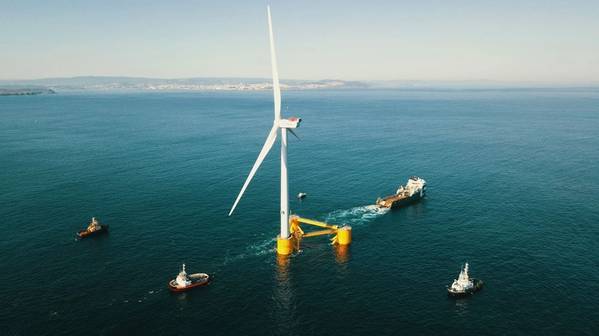
The floating offshore wind industry, still considered nascent with around 100MW installed capacity - and minuscule compared to the installed capacity of its „older brother,“ - that is the conventional, fixed bottom offshore wind industry (29GW at 2019 end) - is showing promise and is expected to take off big time by the end of the decade.
While the current installed capacity is small and focused on pilot projects, the potential is there for the floating wind farms to reach and, theoretically, even surpass the installed capacity of the traditional offshore wind turbines, and not by a little, given that there are no water depth limitations for installation.
Offshore Engineer TV's Greg Trauthwein interviewed Philip Lewis, Director of Research, World Energy Reports, author of OUTLOOK FOR OFFSHORE WIND POWER, THE FRONTIER OF FUTURE ENERGY, to learn more about the opportunities and challenges in the industry that could rise to prominence sooner that one might think. (See the full interview at the bottom of the article)
Lewis first provided some context on the traditional offshore wind industry, which uses fixed-bottom turbines installed at water depths of up to 60 meters.
“…bottom-fixed offshore wind farms have been in operation since 1991, and so this is not a new industry. We saw the true industrialization of the sector over the last decade and the adoption by more and more European and East Asian countries of this increasingly cost-competitive technology,” he said.
80% of wind resource found in deeper waters
However, Lewis says the reason World Energy Reports is so interested in floating offshore wind is the sheer amount of resource available beyond the 60-meter water depth, the general threshold considered for floating solutions.
“Some 80% of the world’s wind resource is found in deeper waters suited to floating wind foundations. These resources are generally able to access higher quality wind resource. Further, floating structures can deploy larger turbines which support higher capacity factors, which means they produce more electricity,” Lewis says.
So, where are we at right now? We are passing from the prototype and demonstration project phase towards industrial-scale floating wind farms, Lewis says.
According to World Energy Reports, the floating wind installed capacity will reach between 8 to 10 GW by the end of this decade, and next decade WER expects to see more than 60GW of floating wind farms commissioned.
Worth reminding, DNV GL recently said that floating wind could grow 2000-fold, by 2050 (DNV-GL), from 100 MW today to 250 GW in 2050.
Big opportunity for offshore O&G supply chain firms
 Bourbon AHTS towing a floating wind turbine to location off Portugal earlier this year
Bourbon AHTS towing a floating wind turbine to location off Portugal earlier this year
Lewis says that the expected growth in the floating wind industry also represents a significant opportunity to those in the supply chain, and the companies that have traditionally served the offshore oil and gas industry, too.
According to WER's offshore wind report, floating offshore projects differ from bottom fixed in that offshore construction and installation calls on methods very familiar to oil & gas offshore yards and offshore support vessel (OSV) owners and operators.
“At World Energy reports we see the opportunities for traditional offshore and marine companies that support the oil and gas sector like offshore yards, mooring system chain and anchor manufacturing and OSV operators. We also see exciting opportunities for those not traditionally involved in the offshore oil and gas market, such a pre-cast concrete and in-situ concrete contractors and manufacturers of synthetic ropes,” Lewis says, however warning that WER does not feel that the supply chain has fully embraced the scope and scale of the opportunities that exist in this sector.
60 concepts
World Energy Reports is tracking some 60 floating wind substructure concepts. Of these 60, 38 have been tank tested and 20 scale tested in the field and 3 concepts have been demonstrated at full scale.
“Only 2 concepts have reached the stage of pilot array to date, although several more concepts will reach this stage over the next couple of years. We expect to see the first pre-commercial arrays - that’s under 100MW by 2022 - and the first commercial arrays over 100MW by the middle of the decade,” Lewis says.
With any opportunities, invariably, there are challenges. To learn what these might be for the floating wind industry, watch our full interview below.